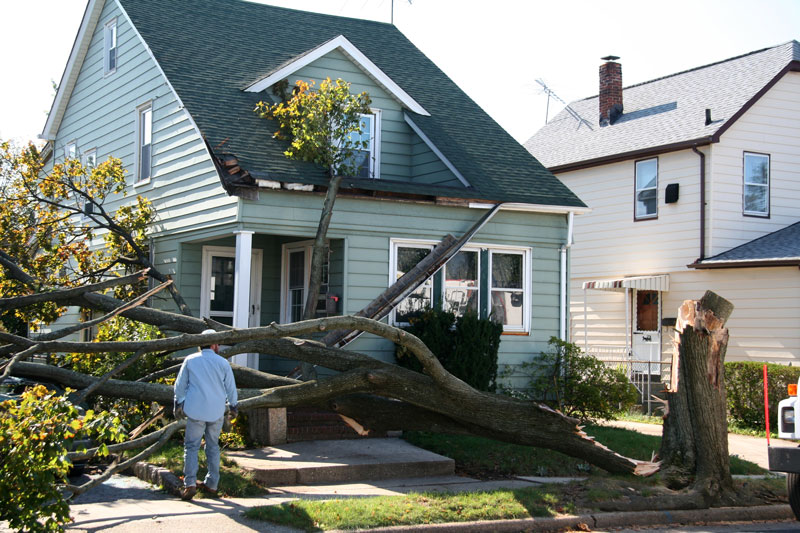How to Reduce Wind Damage
Severe storms often bring with them strong winds that can cause a lot of damage to your home in the chaos. It's impossible, though, to predict how much damage could be done. Luckily, there are preventative steps you can take to mitigate the possible harm done, meaning fewer repair costs and relieved stress for you. Here are some things you can do to reduce wind damage before a storm, brought to you by our storm cleanup professionals.
Regularly Inspect Your Roof
At least once or twice a year, you should make it a priority to break out a ladder and climb up to give your roof a check-up. If there are any developing or urgent issues, this will give you the chance to resolve them before they cause more severe problems during the next storm. Strong winds can rip up your roof, tearing away metal, panels, and other materials to enter the home, causing further harm inside. An already damaged roof (whether from a previous storm or simply from the wear of age) is even more susceptible to wind damage if maintenance is neglected. Check for loose or missing shingles, bare spots, detached sheathing, debris, exposed fasteners (i.e. screws, nails, bolts), leaks, and loose elements such as a chimney or a skylight. You can also call a roofing professional to perform a more thorough inspection or if you discover a concern and don't feel qualified enough to address it on your own. A trained professional is, unsurprisingly, usually the safer choice to complete repairs you can't do and to find problems that you may overlook.
Clean the Yard
What's surrounding the outside of your home can cause serious damage when a storm hits, so take action before the weather even starts to get bad by cleaning your yard of potential problem features. Remove debris that could hit your house or clog street drains during a downpour, like branches, trimmings, and garbage. Regularly clean your gutters to prevent water damage to the roof, don't leave loose and unnecessary belongings outside that could be picked up by heavy wind (if you've been warned of an incoming storm, pick up other perpetually outside items such as chairs, umbrellas, and grills to put into storage until the storm passes), and prune unruly trees and shrubbery. You may also consider replacing rock and gravel landscaping with materials that won't pack as much of a punch if they're hurling towards your home, such as soft wood chips, mulch, or dirt.
Examine Nearby Trees
Of all the things in your yard that pose a threat to your home in a storm, trees are the most dangerous. Examine all the trees in your property, especially those nearest to your house. Make sure they're well pruned, and remove weakened branches that could fall onto the home. Look for limbs that need to be trimmed away from utility lines, as they could pull down the lines or possibly even the entire pole if branches break off. A local utility company or some other professional should be called for this task. Also be on the lookout for trees that are hollowed, diseased, or dead; these weak trees won't be able to withstand the strong winds of a storm and could be ripped out of the ground entirely, propelled straight at your home. If you're worried about a tree like this (or even a large tree growing a little too close to the house) call a professional for removal. As a general rule, a tree shouldn't grow closer to your home than the height of it when it's fully grown to prevent damage if it falls.
Secure Permanently Outside Items
While you should bring in loose, moveable items like grills, umbrellas, or chairs before an incoming storm, items that are more permanent and cannot be easily moved in a hurry should be secured outside. For example, tables, decorations, planter boxes, and tall, heavy furniture should be anchored to the deck, patio, or wall to keep them from becoming projectiles in high winds and avoid putting any furniture close to windows and doors if possible. Playsets can be anchored to the ground using cables or chains. Also, search for any loose boards and/or pieces of your fencing or deck that need to be secured, as they could easily dislocate in a storm.
Cover the Windows and Doors
Windows are a weak point of your home when strong winds throw objects around outside. Installing shutters (especially aluminum or steel storm shutters) to quickly cover those windows in case of an emergency will prevent projectiles crashing through the glass. And if you live in an area where severe storms are common, it's also worth it to look into installing windows specially designed to withstand storm-level air pressure and impact force. If you know a strong storm is on the way, you may want to nail plywood across your home's windows and doors for extra protection.
Reinforce the Garage Door
In addition adding protection to your windows and doors, you can also look into reinforcing your garage door. Strong enough winds can dislodge vulnerable garage doors and wreck the contents inside, and damage to your garage can also lead to damage to the entire home's structure. Hiring a garage door company to determine the strength of your garage door long before a storm will keep you from having to deal with the potential damage afterward.
It's frightening to think how much harm can be caused to your home during a storm by heavy winds and rain. Knowing that you've already taken safeguards to protect your property in advance will help give you some comfort should you find yourself watching a strong storm roll in. Wind damage may not be predictable or completely avoidable, but it can be diminished with these tips.
Do you have any questions or concerns? Disaster Professionals offers 24/7 wind damage restoration and disaster response experts who can answer any questions you may have. We're happy to help!



